Productivity tracking plays a vital role in enhancing an employee’s performance.
It helps you identify unproductive activities, and avoiding them can boost the employee’s performance and improve the organization’s overall efficiency.
In this article, we’ll go over how you can use a productivity report to keep track of your team’s performance, with a free printable employee productivity report template to help you get started. We’ll then cover its limitations and highlight a powerful alternative to templates.
And as a bonus, we’ll also cover seven excellent strategies to boost employee productivity in no time.
This article contains:
(click on the links to jump to a specific section)
- A Handy Employee Productivity Report Template
- What is an Employee Productivity Report?
- 3 Limitations of Using an Employee Productivity Report Template
- A Powerful Alternative to Employee Productivity Report Template
- 7 Proven Strategies to Increase Employee Productivity
Let’s get started.
A handy employee productivity report template
This daily report template contains a table of tasks categorizing tasks as ‘productive’ and ‘unproductive,’ and you can input the total time spent on each task.
It also has a productivity pie chart that visualizes the distribution of tasks in a day. You can use this chart to quickly gauge an employee’s productivity during work hours.
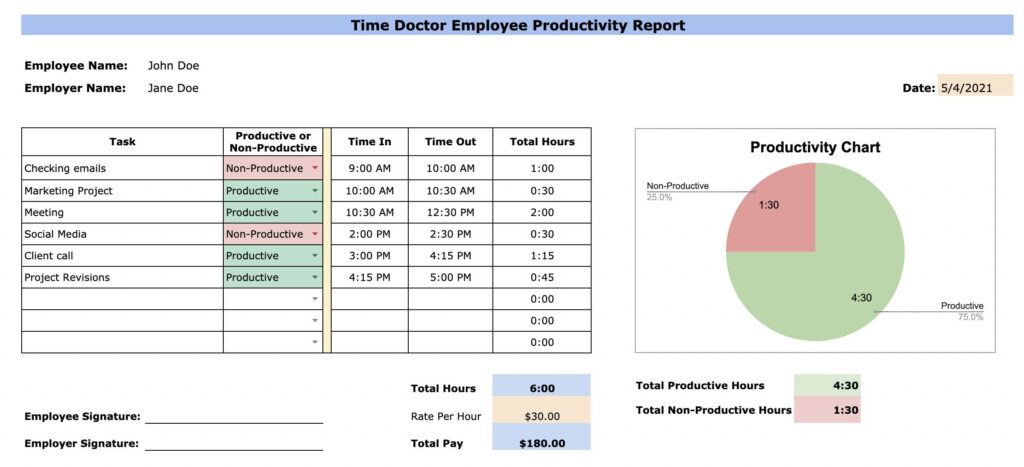
Download links:
- Google Sheet (To create your own copy, click File and then Make a Copy)
- Excel
What is an employee productivity report?
An employee productivity report is a document that usually combines data from various performance metrics like the monthly sales goal and revenue per employee to provide a basic view of employee productivity.
The metric and KPI (Key Performance Indicator) used in the report will depend on the employee’s department. For example, the productivity metric for a marketing employee would be website lead conversion rate or client acquisition cost.
However, there is no set format for an employee productivity report. You can create your own productivity report depending on your requirements.
For example, you can measure the total time an employee spends on a single task or compare actual hours per day and billable hours per day.
You can use a productivity report template to:
- Analyze employee productivity over any period of time.
- Monitor the status of a department in terms of performance, productivity, and employee efficiency.
- Act as a basis for employee performance review meetings, promotion, performance appraisal, and other rewards.
- Measure current employee performance against past data to see if they’re improving.
- Predict future outcomes based on current trends.
3 limitations of using an employee productivity report template
Using an employee productivity template is easy and provides several benefits.
However, templates can be highly limiting when it comes to accurately measuring productivity. Let’s see how:
1. Hard to determine productivity issues
You can’t use productivity report templates to see how productive an employee is while working on specific tasks or projects in real-time.
You’ll only know if their day was productive when they clock out. This can be a problem, as you can’t determine what tasks your team members are struggling with at any given time.
Moreover, a Microsoft Excel spreadsheet doesn’t account for hidden tasks that aren’t directly related to the project, such as:
- Coordinating with team members on phone calls, chat messages, or video calls.
- Informal team chats or water cooler conversations.
- Administrative tasks like client meetings, sending emails, etc.
As a result, you might not know the actual productivity levels of an employee.
2. Data entry can be a hassle
An Excel spreadsheet based productivity report is an unreliable way of storing data.
An Excel template can only be as accurate as the data entered into it. Even if employee hours are recorded honestly, there’s always room for human error during documentation.
Additionally, with state and federal labor laws regarding overtime hours constantly changing, any mistakes made while calculating overtime can land your company in legal issues.
Moreover, as each edition of weekly timesheet data will lead to an increase in the volume of information, you’ll have tons of data on hand to analyze trends for performance evaluation — which can be a tedious process.
3. Time consuming
Filling an employee productivity report template is not only time-consuming but also labor-intensive.
While it does help track hours worked, it can be a tedious task because you’ll either have to manually fill and calculate it yourself or ask an HR department (Human Resource) representative to do it for you.
This lack of automation translates to a lot of work.
And if you’re managing a large team, checking every individual timesheet just adds up to the workload. While you can hire a virtual assistant to handle it for you, it could affect your budget.
A powerful alternative to employee productivity report template
Using an employee productivity tracking software is the best alternative to a report template.
These tools are user-friendly and help you avoid the hassle of manually filling in data at the end of each day.
Moreover, most productivity management tools offer various other features like time tracking, productivity ratings, etc., to help you easily differentiate between productive and unproductive activities.
Time Doctor is the ultimate productivity management solution in 2021.
What is Time Doctor?
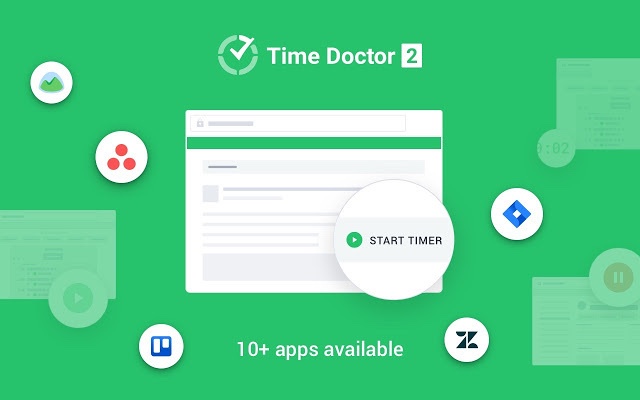
Time Doctor is a powerful employee productivity management tool used by major companies like BBB (Better Business Bureau) and small businesses like Thrive Market to boost team productivity.
From creating work schedules and attendance reports to payroll management and time sheets, this productivity monitoring software can do more than just track time.
Let’s take a look at why Time Doctor is way better than using a productivity report template:
1. Time tracking
The first step to monitor productivity is to track time, and Time Doctor helps you do just that.
It’s one of the most simple and user-friendly time tracking solutions available today.
To track the time in the interactive mode, all you need to do is:
- Download and install the Time Doctor app.
- Sign up for a new account or log in with your existing credentials.
- Enter the name of your task.
- Click on the ‘Play’ button to start tracking time.
And when you’re done for the day or want to take a break from work, you can simply click on the ‘Stop’ button, and the time tracker stops tracking time.
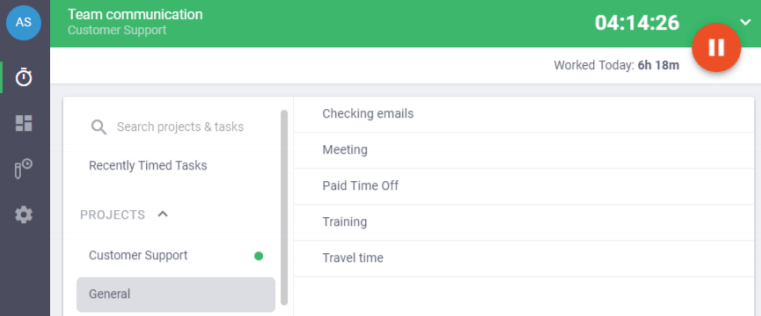
Note: Time Doctor also provides an automatic time tracking mode for effortless time tracking.
2. Productivity ratings
To get an accurate employee productivity measurement, you need to understand how your employees spend their time — not just how long they spent on each task.
That’s why Time Doctor allows project managers to assign productivity ratings to each website or application based on their productivity levels.
Why?
Rating social media platforms like Facebook as ‘unproductive’ can be right for an accountant. But for a marketing assistant, it can be a part of their job.
So to avoid inaccurate reporting, Time Doctor allows you to rate websites and apps as:
- Productive
- Unproductive
- Neutral
- Unrated
The ratings can be applied to any application or website and reflected across the entire company, team, or specific employees.
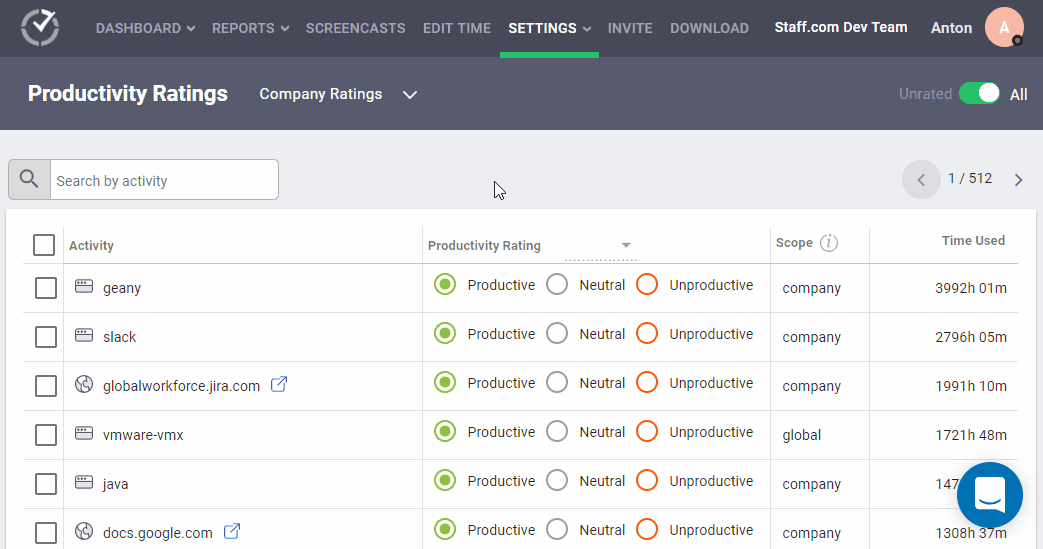
3. Performance reports
Time Doctor’s accurate reports provide actionable insights into your employees’ individual productivity.
Let’s take a quick look at these reports:
- Activity summary report: View active minutes, seconds, unproductive, manual, and mobile time for each employee over a selected time period.
- Hours tracked report: See the number of hours tracked by employees per day, week, or for any date range.
- Attendance report: Know when a user is present, absent, partially absent, or late in real time.
- Custom export: Customize all the fields you’d like to include in one single report.
- Projects & tasks report: View the time spent on whole projects and individual tasks.
- Timeline report: Visualize the time spent on tasks and breaks. The weekly report shows the time tracked in a week.
- Web and app usage report: See the time spent by an employee on each app and website during work hours.
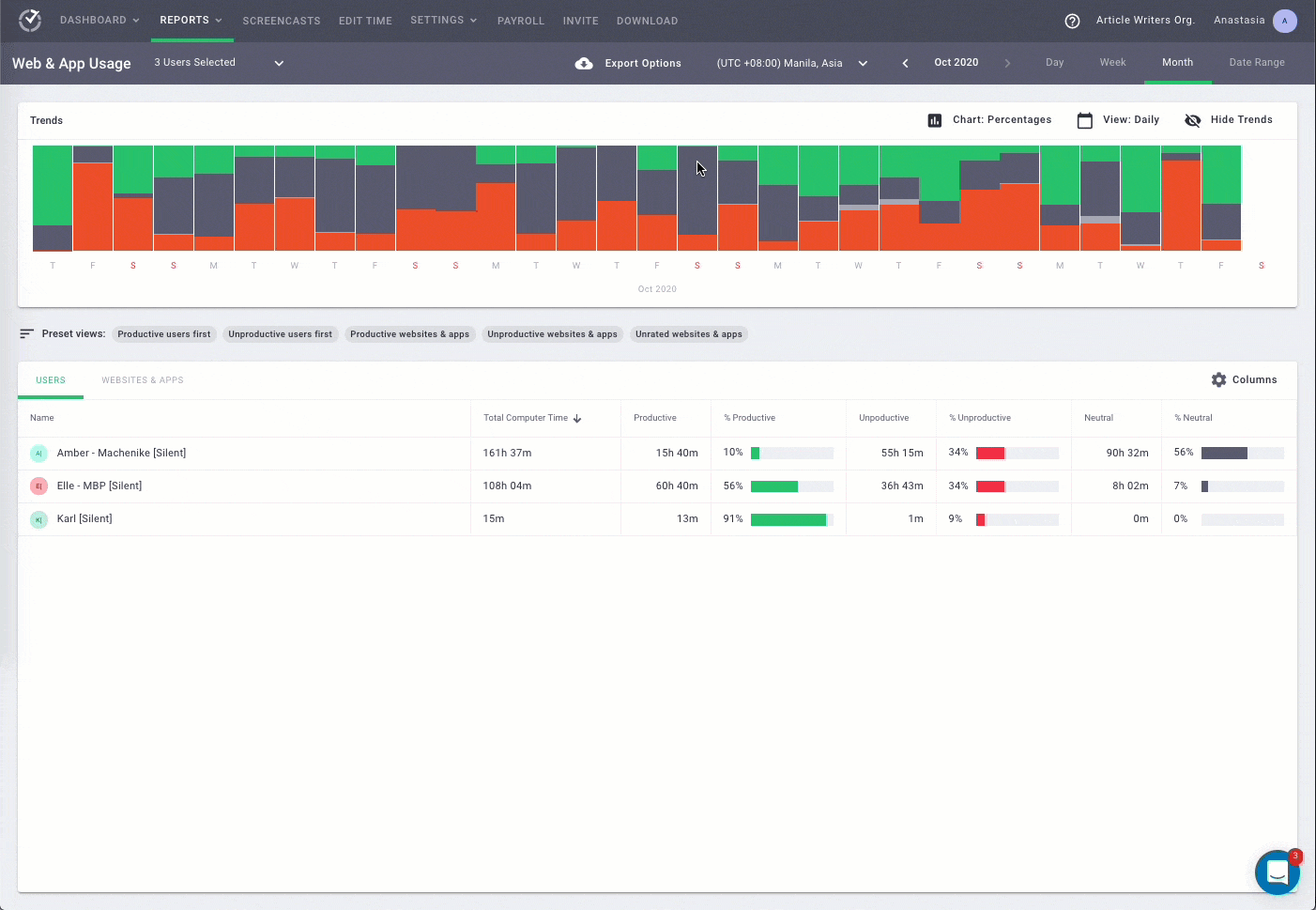
4. Screencasts
Screencasts are an optional feature that can be enabled for additional productivity monitoring.
This feature allows you to take screenshots or screencasts (videos) of employees’ screens at random intervals during work hours.
Time Doctor offers three settings for this feature:
- Screenshots: Specify a time interval at which random screen captures will be taken.
- Videos: A continuous video is broken down into three-minute clips.
- Off: No screenshot or video.
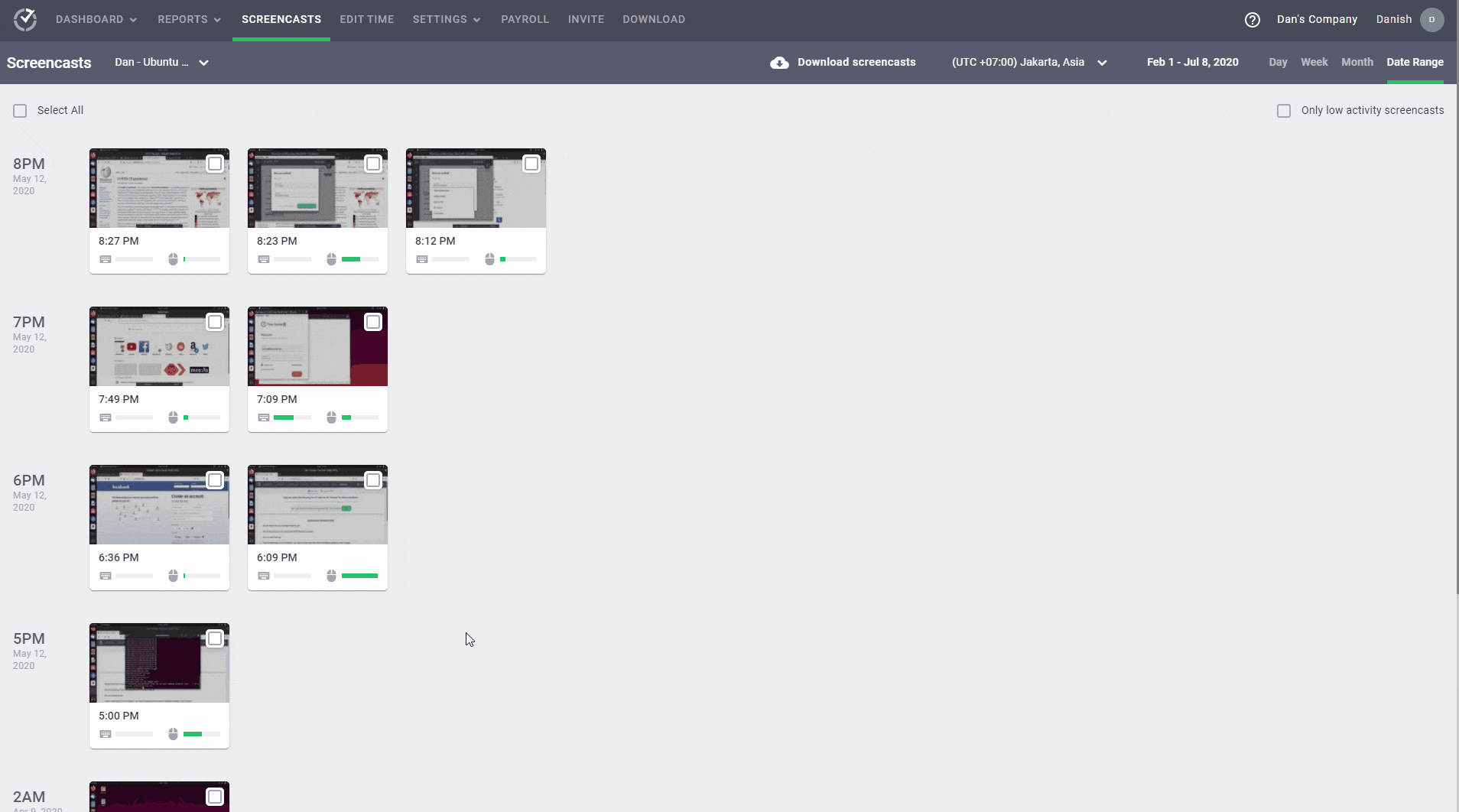
Note: To protect employee privacy, Time Doctor lets you blur/delete screencasts with sensitive information.
7 proven strategies to increase employee productivity
Now that you know how to monitor productivity, let’s take a look at seven simple strategies that can help you boost employee productivity in no time:
1. Set clear goals
Unclear goals can be one of the major causes of low productivity levels.
How?
If employees are unsure of what’s expected of them, they’ll spend time on unimportant or unproductive activities.
To avoid this, you must set clear goals and targets for your entire team and for each member.
However, if you focus exclusively on personal productivity, you wouldn’t learn about any team’s shortcomings, like poor collaboration.
So how can you achieve this?
You can follow some tips like:
- Be clear and detailed in your instructions.
- Conduct an employee survey to assess how motivated your team members are.
- Consider having frequent meetings to boost employee engagement.
- Ensure that things aren’t lost in translation due to remote work.
With everything out in the open, your employees will be able to see the bigger picture and how their contributions impact the company mission and objectives.
2. Monitor employee productivity regularly
The easiest way to enhance productivity is to monitor it continually over a period.
Continuous productivity monitoring can help:
- Identify unproductive activities and trends.
- Gain insight into everyone’s work behavior.
- Distinguish between productive and unproductive employees.
Once you’re done analyzing employees, you can draw up a plan to determine how to boost their performance.
3. Don’t micromanage
Micromanagement can lead to low employee satisfaction and greater employee turnover.
And while providing feedback can be helpful, criticizing your employees on a regular basis can lower employee morale. It can be frustrating for both the employees and team managers.
To prevent this, here are a few things you can do:
- Delegate tasks to experienced employees.
- Set clear objectives for the assigned projects.
- Allow your employees to do tasks their way (as long as it doesn’t affect the end result).
- Have conversations with your employees to understand how they want to be managed.
4. Allow flexible work schedules
Showing up late for work or not turning up at all can also contribute to decreasing productivity.
That’s why you should allow flexible work schedules.
Flexible schedules allow employees to work when they feel the most productive. This also gives them the freedom to start work when they want, creating a better work-life balance.
However, you should set a minimum number of work hours. This ensures that everyone is working to their fullest potential and not running behind on their assigned tasks.
Learn about all the types of flexible work schedules here.

5. Conduct team-building activities
Highly focused and engaged employees are a vital part of productive company culture.
So to boost employee engagement and bring your employees together as a team, you should conduct team-building activities like Code Break or Team Pursuit.
You can set this up either weekly or on a monthly basis.
How does this help?
Spending more time together can help your employees bond socially and move past their differences. Additionally, this encourages your employees to stop thinking as individuals and work towards their goals as a team!
6. Reward achievements
Criticism should not be the only result of performance evaluation.
You should reward your employees for their efforts as well. This shows that you care about their efforts and hard work.
Here are a few tips to help you reward employees the right way:
- Use merit-based compensation and salary hikes during employee performance evaluation.
- Write a simple thank-you note after they’ve helped you with a task.
- Allow them to take a few days off after they’ve worked on a weekend.
- Share a few words of appreciation in front of team members.
7. Provide the right tools
Using the right tools helps save time and streamline workflows – which translates to improved productivity.
However, employee management software is not the only tool you need.
Few other essential office productivity software that your remote employees might need:
- Asana, Trello for easy project management.
- Slack for instant communication and chats.
- Zoom and Skype to conduct performance review sessions.
- Business reporting software like Hive and Zoho Analytics for work-related charts.
Additionally, to keep track of your monthly expenses, you need tools like Freshbooks or QuickBooks.
And for enhanced productivity, you should ensure that your productivity management tool integrates with other business tools you’re using. Fortunately, Time Doctor integrates with 50+ tools for maximum functionality.
Wrapping up
Using employee productivity report templates is a good way to track productivity. But they are unreliable, time-consuming, and don’t provide a detailed picture of an employee’s productivity.
Instead, what you need is a powerful employee productivity management tool like Time Doctor.
Time Doctor not only helps you track time but also identifies unproductive activities. It even offers advanced features like productivity reports, offline time tracking, and a powerful Android app to track time anywhere.
So why not sign up for Time Doctor today and boost your remote team productivity?

Liam Martin is a co-founder of Time Doctor which is software to improve productivity and help keep track and know what your team is working on, even when working from home.


